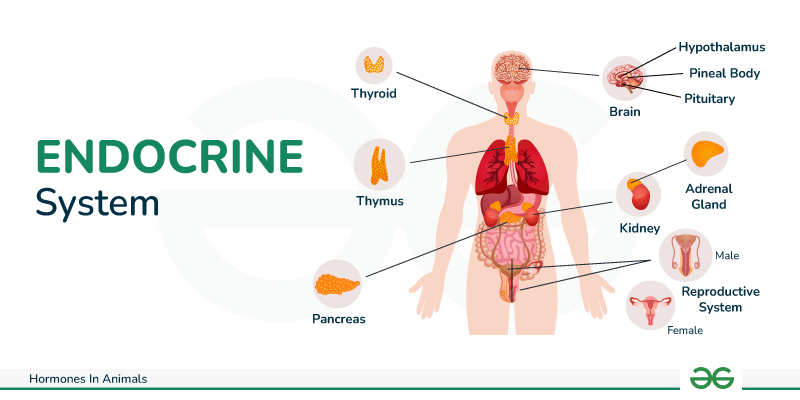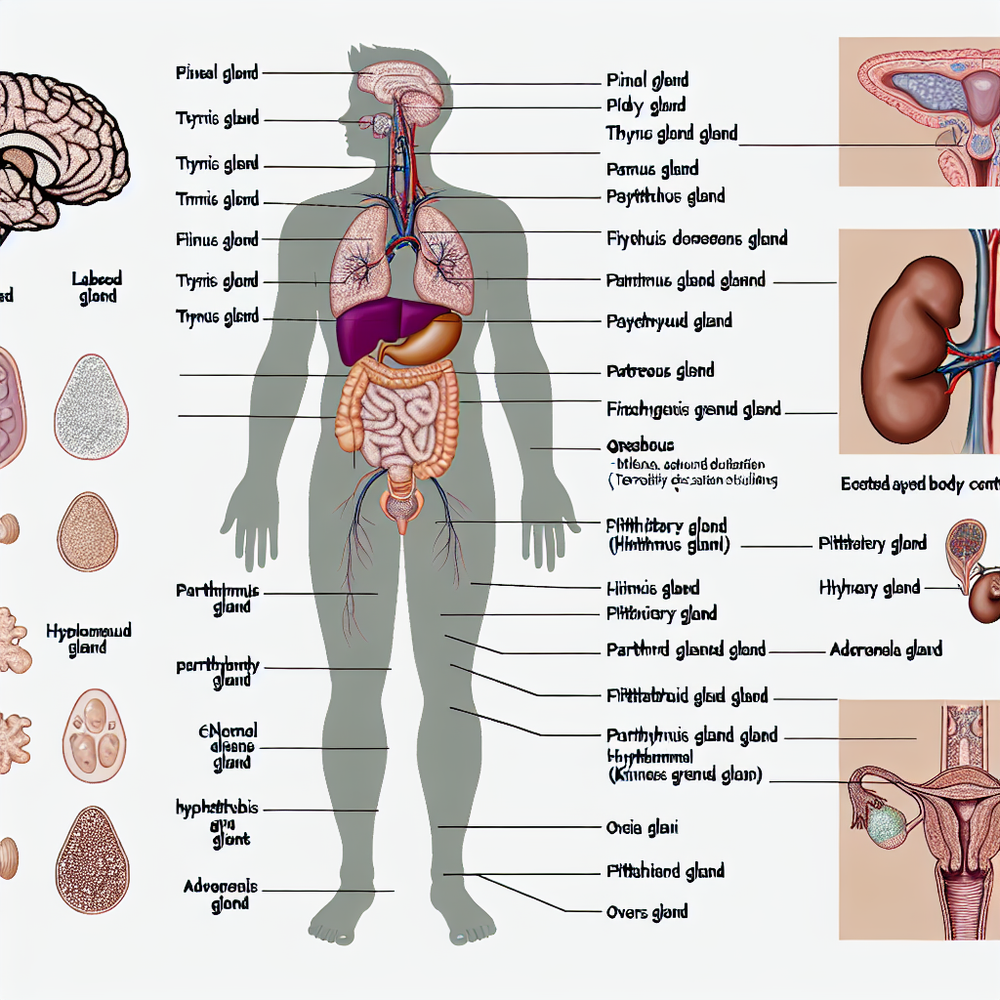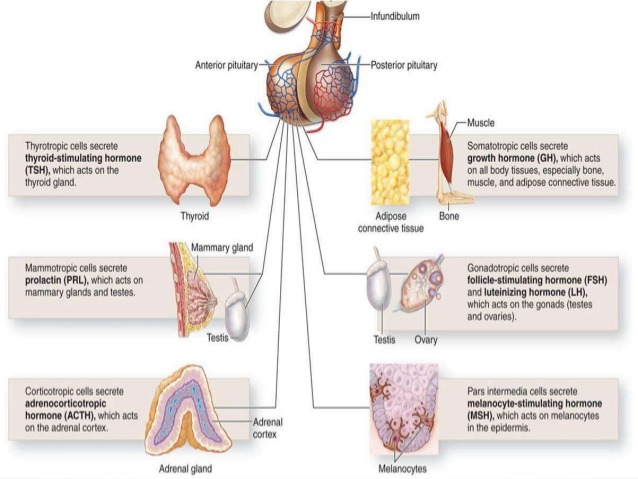A mammalian endocrine system chart visually maps the complex network of glands and hormones that regulate essential bodily functions. You’ll see major glands like the pituitary, thyroid, and adrenals, along with their locations and primary hormones. The chart typically shows hormone pathways and target organs, helping you understand how these chemical messengers influence growth, metabolism, and reproduction. It’ll highlight feedback loops that maintain hormonal balance and may include common endocrine disorders. By studying this chart, you’ll gain insights into how the endocrine system interacts with other body systems to maintain homeostasis. Exploring further will reveal the intricate details of this fascinating biological network.
Understanding the Endocrine System

The endocrine system‘s complexity can be intimidating, but understanding its basics is crucial for grasping mammalian biology. This intricate network of glands and hormones regulates numerous bodily functions, from growth and metabolism to reproduction and stress response. You’ll find that the endocrine system works in tandem with the nervous system to maintain homeostasis and coordinate long-term processes in the body.
At its core, the endocrine system consists of glands that secrete hormones directly into the bloodstream. These chemical messengers travel throughout the body, targeting specific cells or organs to elicit responses. You’ll encounter major glands like the pituitary, thyroid, parathyroid, adrenal, pancreas, and reproductive glands (ovaries in females, testes in males). Each gland produces specific hormones that influence various physiological processes.
To fully grasp the endocrine system, you’ll need to understand the concept of negative feedback loops. These mechanisms help maintain balance by regulating hormone production. When hormone levels rise, they trigger a response that decreases their production, and vice versa. This self-regulating system guarantees that hormone levels remain within ideal ranges.
You’ll also discover that hormones can be classified into different types based on their chemical structure. These include amino acid-derived hormones, peptide hormones, and steroid hormones. Each type has unique properties that affect how they’re synthesized, transported, and interact with target cells.
Key Glands and Their Functions

Now that you’ve grasped the basics of the endocrine system, let’s explore the key glands and their specific functions. The pituitary gland, often called the “master gland,” sits at the base of your brain and controls many other endocrine glands. It produces hormones that regulate growth, metabolism, and reproduction.
The thyroid gland, located in your neck, secretes hormones that control metabolism and energy production. It’s essential for maintaining body temperature and proper growth. Just behind the thyroid, you’ll find the parathyroid glands, which regulate calcium levels in your blood and bones.
Your adrenal glands, situated atop each kidney, produce hormones like cortisol and adrenaline. These hormones help you respond to stress and regulate blood pressure. The pancreas, located in your abdomen, secretes insulin and glucagon to control blood sugar levels.
In the reproductive system, the ovaries in females and testes in males produce sex hormones like estrogen and testosterone. These hormones are critical for sexual development and reproduction.
The pineal gland, deep within your brain, produces melatonin, which regulates your sleep-wake cycle. The thymus, located in your chest, plays an important role in your immune system’s development during childhood.
Hormones and Their Target Organs

From within the complex network of the endocrine system, hormones travel through your bloodstream to reach their target organs. These chemical messengers play vital roles in regulating various bodily functions. Let’s explore some key hormones and their corresponding target organs.
Insulin, produced by the pancreas, targets muscle, fat, and liver cells. It’s essential for glucose metabolism and energy storage. Glucagon, also from the pancreas, acts on the liver to increase blood glucose levels. Your thyroid gland secretes thyroxine and triiodothyronine, which affect nearly every cell in your body, regulating metabolism and growth.
The adrenal glands produce several hormones. Cortisol targets multiple organs, influencing metabolism, immune response, and stress management. Epinephrine and norepinephrine act on the heart, blood vessels, and various tissues to trigger the “fight or flight” response.
Growth hormone, released by the pituitary gland, targets bones, muscles, and other tissues to promote growth and cell reproduction. The pituitary also produces prolactin, which stimulates milk production in mammary glands.
Your reproductive system relies on hormones like estrogen and testosterone. Estrogen, primarily produced in ovaries, affects various tissues, including the uterus, breasts, and bones. Testosterone, mainly from the testes, influences muscle mass, bone density, and sexual characteristics.
Parathyroid hormone targets bones and kidneys to regulate calcium levels in your blood. Calcitonin, from the thyroid gland, also helps maintain calcium balance by acting on bones.
Understanding these hormone-target organ relationships helps you appreciate the intricate coordination within your endocrine system, ensuring your body’s proper functioning and homeostasis.
Reading an Endocrine System Chart
Having explored the various hormones and their target organs, it’s time to visualize this information in a practical format. An endocrine system chart is a valuable tool that presents complex hormonal interactions in a clear, organized manner. When reading such a chart, you’ll typically find glands listed on one axis and their corresponding hormones on the other.
Start by familiarizing yourself with the chart’s layout. You’ll notice that major endocrine glands like the pituitary, thyroid, and adrenal glands are prominently featured. Look for color-coding or symbols that indicate relationships between glands and hormones. Pay attention to arrows, which often show the direction of hormonal influence.
As you scan the chart, focus on one gland at a time. Identify the hormones it produces and trace their paths to target organs. You’ll see that some glands, like the pituitary, produce multiple hormones affecting various parts of the body. Others, such as the thyroid, may have a more specific focus.
Don’t overlook feedback loops depicted in the chart. These illustrate how hormone levels are regulated through complex interactions between glands. For example, you’ll observe how the hypothalamus influences the pituitary, which in turn affects other glands.
Remember that these charts are simplifications of intricate biological processes. They provide a snapshot of the endocrine system’s main components but may not capture every nuance. Use the chart as a starting point for understanding hormonal relationships, and refer to more detailed resources for in-depth information on specific interactions.
Major Endocrine Pathways
Exploring the major endocrine pathways reveals the intricate network of hormonal communication within the body. You’ll find that these pathways are fundamental for maintaining homeostasis and regulating various physiological processes.
The hypothalamic-pituitary axis is a key pathway you’ll encounter. It involves the hypothalamus releasing hormones that control the pituitary gland, which in turn influences other endocrine glands. This axis regulates growth, reproduction, and stress responses.
You’ll also see the thyroid pathway, where the hypothalamus and pituitary control the thyroid gland’s production of thyroxine and triiodothyronine. These hormones regulate metabolism and energy production throughout the body.
The adrenal pathway is another critical system you’ll notice. It involves the hypothalamus and pituitary controlling the adrenal glands, which produce cortisol and aldosterone. These hormones manage stress responses and fluid balance.
You’ll find the reproductive pathway, which differs between males and females. In males, it involves the hypothalamus, pituitary, and testes, while in females, it includes the hypothalamus, pituitary, and ovaries. These pathways regulate sexual development and reproduction.
The pancreatic pathway is important for glucose regulation. You’ll see how the pancreas produces insulin and glucagon to maintain blood sugar levels.
Lastly, you’ll encounter the parathyroid pathway, which controls calcium homeostasis through the production of parathyroid hormone. This pathway is essential for bone health and muscle function.
Understanding these major endocrine pathways will help you grasp the complexity of hormonal regulation in mammals.
Feedback Loops in Hormone Regulation
Precision is key when it comes to hormone regulation in mammals. Your body relies on intricate feedback loops to maintain hormonal balance and guarantee proper physiological function. These loops can be either negative or positive, with negative feedback being the more common mechanism.
In a negative feedback loop, the end product of a hormonal pathway inhibits further hormone production. For example, when your thyroid gland produces thyroxine, it signals the hypothalamus and pituitary to reduce the release of thyroid-stimulating hormone (TSH). This prevents overproduction of thyroid hormones and maintains homeostasis.
Positive feedback loops, though less common, are vital in certain situations. During childbirth, for instance, oxytocin release stimulates uterine contractions, which in turn triggers more oxytocin production. This cycle intensifies until the baby is born.
You’ll find that most endocrine glands are controlled by the hypothalamus-pituitary axis. The hypothalamus secretes releasing or inhibiting hormones that act on the pituitary, which then produces tropic hormones to stimulate target glands. These glands respond by releasing their specific hormones, which eventually feedback to the hypothalamus and pituitary.
It’s important to note that feedback loops can be disrupted by various factors, including stress, medications, and certain medical conditions. When this happens, you may experience hormonal imbalances that can lead to a range of symptoms and health issues. Understanding these regulatory mechanisms can help you appreciate the complexity of your endocrine system and the significance of maintaining hormonal equilibrium.
Endocrine Disorders and Imbalances
While your endocrine system usually maintains a delicate balance, various factors can disrupt this equilibrium, leading to endocrine disorders and imbalances. These disruptions can occur in any of your endocrine glands, affecting hormone production, secretion, or reception.
You’ll find that common endocrine disorders include diabetes, thyroid disorders, and adrenal insufficiency. Diabetes results from your body’s inability to regulate blood sugar levels due to issues with insulin production or utilization. Thyroid disorders, such as hypothyroidism or hyperthyroidism, stem from an under- or overactive thyroid gland, affecting your metabolism and energy levels. Adrenal insufficiency, like Addison’s disease, occurs when your adrenal glands don’t produce enough cortisol or aldosterone.
Hormonal imbalances can also manifest as growth disorders, reproductive issues, or metabolic problems. For instance, growth hormone deficiency can lead to short stature, while excess production can cause gigantism or acromegaly. Polycystic ovary syndrome (PCOS) in women and hypogonadism in men are examples of reproductive endocrine disorders.
You should be aware that endocrine imbalances can result from various causes, including genetic factors, autoimmune conditions, tumors, or environmental influences. Symptoms often vary widely, depending on the specific disorder and affected gland. They may include fatigue, weight changes, mood swings, or changes in hair growth.
If you suspect an endocrine disorder, it’s essential to consult an endocrinologist. They’ll conduct thorough examinations, including blood tests and imaging studies, to diagnose and develop a treatment plan. Management typically involves hormone replacement therapy, medication, lifestyle changes, or sometimes surgery to restore hormonal balance and alleviate symptoms.
Comparative Mammalian Endocrinology
Comparative mammalian endocrinology reveals fascinating similarities and differences in hormone systems across various species. You’ll find that most mammals share the same major endocrine glands, including the pituitary, thyroid, parathyroid, adrenal, and pancreas. However, the specific functions and hormones produced can vary greatly.
For instance, while humans and other primates have a menstrual cycle, most other mammals experience estrous cycles. This difference affects the production and timing of reproductive hormones. You’ll also notice that some mammals, like bears and bats, have evolved specialized endocrine adaptations for hibernation, allowing them to regulate metabolism and conserve energy during long periods of inactivity.
Marine mammals, such as whales and seals, have unique endocrine adaptations for their aquatic lifestyle. They’ve developed specialized mechanisms to regulate salt balance and water conservation, often involving modifications to their adrenal glands.
When you examine smaller mammals like rodents, you’ll find they have a more active thyroid gland compared to larger mammals, which helps maintain their high metabolic rate. Conversely, larger mammals like elephants have evolved endocrine systems that support their massive size and longevity.
You’ll also discover that some hormones serve different functions across species. For example, prolactin, primarily known for its role in lactation in humans, plays a vital part in osmoregulation in fish and amphibians.
Endocrine System Development
Throughout mammalian development, the endocrine system emerges as a complex network of glands and organs. You’ll find that this intricate system begins to form during early embryonic stages, with various endocrine tissues differentiating from the three primary germ layers: ectoderm, mesoderm, and endoderm.
From the ectoderm, you’ll see the development of the pituitary gland and adrenal medulla. The anterior pituitary originates from Rathke’s pouch, while the posterior pituitary forms from neural tissue. The mesoderm gives rise to the adrenal cortex, gonads, and pancreatic islets. The thyroid, parathyroid, and thymus glands, along with the endocrine cells of the gastrointestinal tract, emerge from the endoderm.
As development progresses, you’ll notice that these endocrine structures undergo further specialization and maturation. Hormones play vital roles in this process, often regulating their own development through feedback loops. For instance, the hypothalamic-pituitary axis forms early, coordinating the development and function of other endocrine glands.
You’ll observe that the timing of endocrine system development varies among mammalian species. In humans, most endocrine glands are functional by the end of the first trimester, while in some other mammals, significant maturation occurs postnatally. Environmental factors, nutrition, and genetic influences can all impact endocrine system development.
Understanding this developmental process is essential, as disruptions during critical periods can lead to long-lasting effects on endocrine function and overall health. By studying endocrine system development, you’ll gain insights into normal physiology and potential origins of endocrine disorders.
Integrating With Other Body Systems
The endocrine system‘s integration with other body systems is a marvel of biological coordination. You’ll find that this system doesn’t work in isolation but collaborates closely with the nervous, immune, and circulatory systems to maintain homeostasis and regulate bodily functions.
With the nervous system, the endocrine system forms the neuroendocrine axis. This partnership allows for rapid and long-term responses to stimuli. For example, when you’re stressed, your hypothalamus signals the pituitary gland to release hormones, which then stimulate the adrenal glands to produce cortisol.
The immune system and endocrine system communicate bidirectionally. Hormones like cortisol and estrogen can modulate immune responses, while cytokines produced by immune cells can influence hormone production. This interaction is essential for your body’s defense against pathogens and overall health maintenance.
Your circulatory system serves as the highway for hormones. It transports these chemical messengers from endocrine glands to target tissues throughout your body. The blood-brain barrier, a specialized structure in your circulatory system, regulates which hormones can enter the brain, protecting this crucial organ from potentially harmful substances.
The endocrine system also interacts with your digestive system. Hormones like insulin, glucagon, and ghrelin regulate metabolism and appetite. They influence how your body processes nutrients and stores energy.
Understanding these intricate connections helps you appreciate the complexity of your body’s functions. It’s this seamless integration that allows your endocrine system to effectively regulate growth, development, reproduction, and numerous other physiological processes.

Erzsebet Frey (Eli Frey) is an ecologist and online entrepreneur with a Master of Science in Ecology from the University of Belgrade. Originally from Serbia, she has lived in Sri Lanka since 2017. Eli has worked internationally in countries like Oman, Brazil, Germany, and Sri Lanka. In 2018, she expanded into SEO and blogging, completing courses from UC Davis and Edinburgh. Eli has founded multiple websites focused on biology, ecology, environmental science, sustainable and simple living, and outdoor activities. She enjoys creating nature and simple living videos on YouTube and participates in speleology, diving, and hiking.
